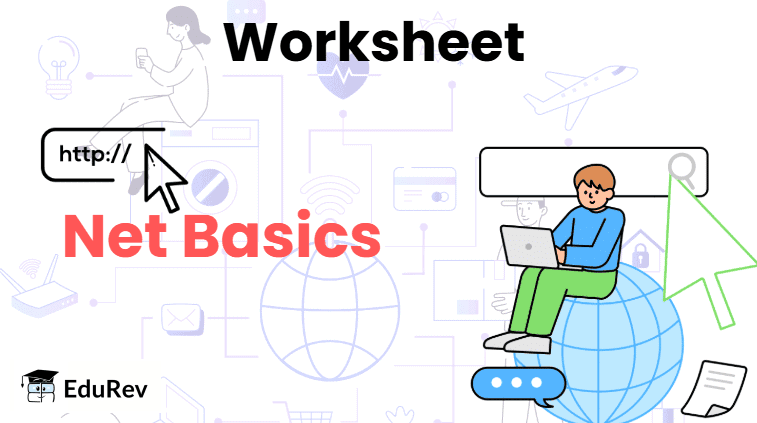Worksheet: Net Basics | General Knowledge for Young Learners - Class 1 PDF Download
| Table of contents |

|
| MCQs |

|
| Fill in the Blanks |

|
| True or False |

|
| Match the Following |

|
| Riddles! |

|
| Short Answer Questions |

|

MCQs
Q1: What was the first development in the history of the Internet?
A) Introduction of web browsers
B) Host-to-host network interactions
C) Personal computers
D) Wireless communication
Q2: Which protocol is used for transferring hypertext?
A) TCP
B) FTP
C) HTTP
D) ISDN
Q3: In which decade was the Transmission Control Protocol (TCP) developed?
A) 1960s
B) 1970s
C) 1980s
D) 1990s
Q4: What does Wi-Fi stand for?
A) Wireless Fidelity
B) Wide Fidelity
C) Wireless Form
D) Wide Form
Q5: What is a disadvantage of Internet usage mentioned in the text?
A) Easy access to information
B) Online education
C) Dependency on technology
D) Job hunting
Fill in the Blanks
Q1: The first general usage of computer networks was observed in __________.
Q2: The __________ protocol enables different machines to assemble data packets.
Q3: In the 1970s, the focus was on __________ the usage of transistors and transmitters.
Q4: __________ is a wireless communication method that uses radio waves.
Q5: The __________ allows users to send audio or video data using telephone lines.
True or False
Q1: The Internet was developed by a single researcher.
Q2: Personal computers increased the demand for commercial Internet usage.
Q3: The introduction of the web browser occurred in the 1980s.
Q4: Cyber crime has decreased with the advent of the Internet.
Q5: Wireless broadband services have made Internet access more convenient.
Match the Following

Riddles!
Q1: I am invisible but connect the world. I help you find answers and watch videos. What am I?
Q2: I have no wires but can still connect you to the Internet. What am I?
Q3: I protect your accounts and keep your data safe. What am I?
Q4: I was the first computer network, born in 1969. What am I?
Q5: I can harm you online, but I’m not a virus. What am I?
Short Answer Questions
Q1: What was the first major development in networking that happened in 1969?
Q2: What is broadband, and why is it popular today?
Q3: Name one way people can connect to the Internet without wires.
Q4: What does TCP/IP stand for, and why is it important?
Q5: List two advantages of using the Internet.
You can access the solutions to this worksheet here.
|
64 videos|153 docs|40 tests
|
FAQs on Worksheet: Net Basics - General Knowledge for Young Learners - Class 1
| 1. What are the basic components of a network? |  |
| 2. What is the difference between a LAN and a WAN? |  |
| 3. How does the Internet work? |  |
| 4. What is an IP address? |  |
| 5. What is the purpose of a firewall in networking? |  |




















